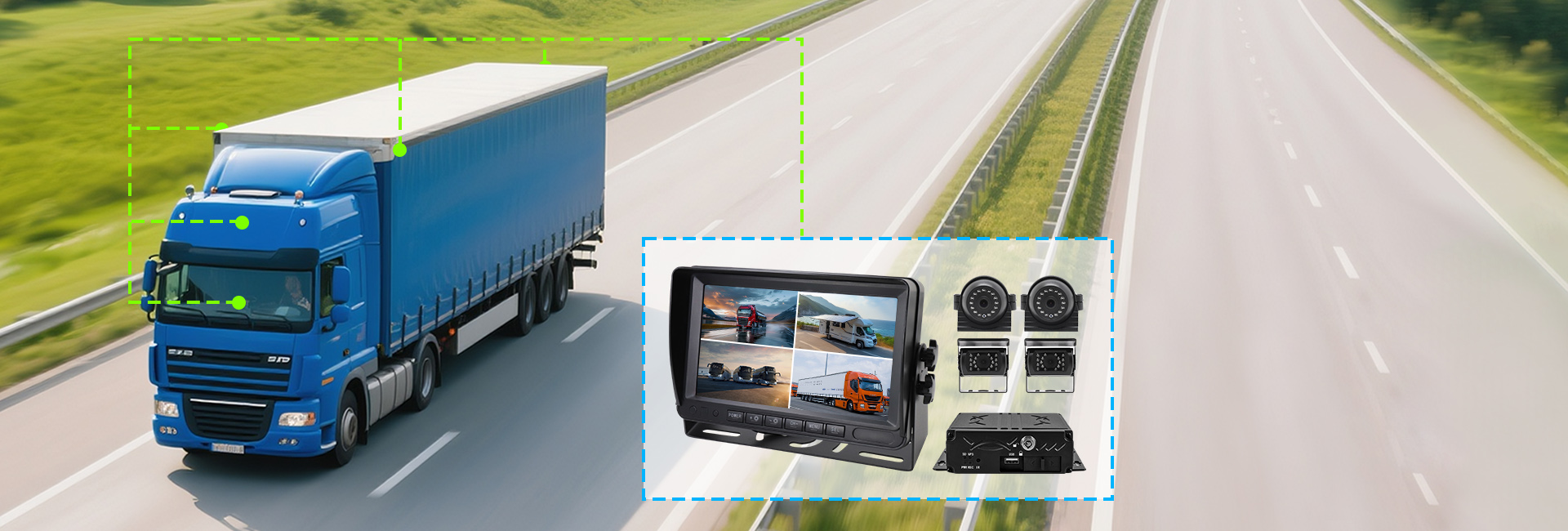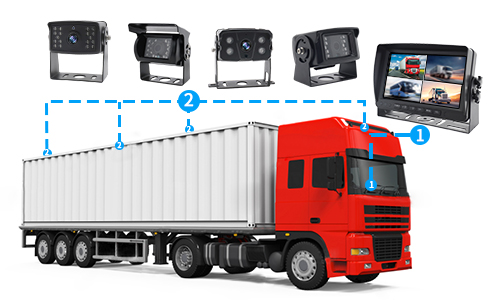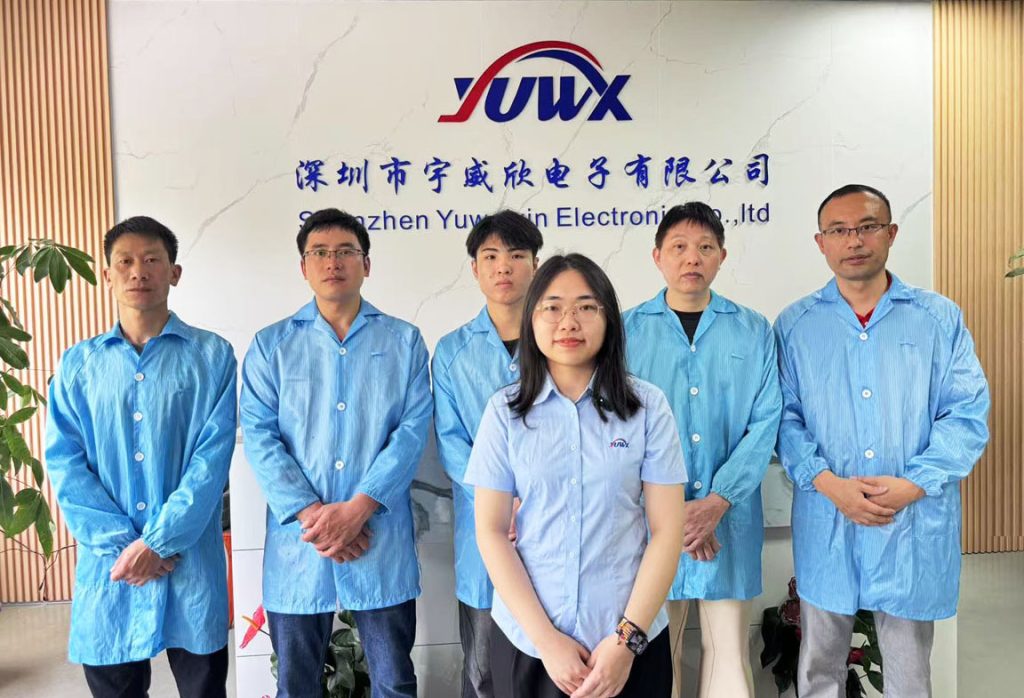In modern commercial transportation, safety and reliability are paramount. Truck drivers face diverse challenges, including extreme weather, low-light conditions, and complex driving environments. Traditional rearview systems often fall short in providing clear visibility, which can compromise safety. To address these challenges, engineers have developed multi-LED truck reversing cameras that enhance visibility, durability, and performance. These cameras are designed to maintain high image quality regardless of external conditions, ensuring drivers can navigate safely. This article explores the engineering behind multi-LED truck cameras, their technological advantages, applications, and the future of vehicle safety solutions.
The Evolution of Truck Rearview Technology
Truck rearview systems have evolved significantly over the past decades. Initially, trucks relied solely on side mirrors and manual observation. While functional, these solutions offered limited visibility, particularly during night driving or adverse weather conditions. The introduction of digital cameras marked a transformative moment in vehicle safety. Single-LED cameras improved low-light visibility to a degree, but their performance in heavy rain, fog, or snow remained limited.
Multi-LED truck reversing cameras emerged as a solution to these limitations. By incorporating multiple light-emitting diodes, these cameras can illuminate a broader area and provide consistent brightness. This innovation reduces blind spots and enhances situational awareness. Furthermore, modern cameras integrate image processing algorithms, which optimize contrast, reduce glare, and enhance color accuracy. The result is a reliable visual system that performs under demanding conditions.

Design Principles of Multi-LED Truck Cameras
The engineering of multi-LED truck cameras involves several core principles. These principles ensure both functionality and durability in extreme conditions.
-
Optimal LED Configuration
Engineers carefully design the number, placement, and intensity of LEDs. This configuration maximizes illumination without causing glare or distortion. LEDs are positioned to cover the truck’s rear field comprehensively. Furthermore, adjustable beam angles allow for dynamic lighting in varying conditions, ensuring uniform visibility across the camera’s range. -
Robust Housing Materials
The camera housing protects sensitive components from environmental stressors. Materials must resist high humidity, temperature extremes, and chemical exposure, such as road salt. Advanced plastics and corrosion-resistant metals are often used. Additionally, housing design includes reinforced seals to prevent water ingress during heavy rain or snow. -
Advanced Optics and Lenses
Optical engineering is critical for clarity and image fidelity. High-quality lenses reduce chromatic aberration and maintain sharp focus across the field of view. Wide-angle lenses are commonly employed to provide a comprehensive view behind the truck. Optical coatings also minimize glare from headlights and sunlight, improving visibility in all conditions. -
Temperature and Shock Management
Truck cameras must endure vibrations and shocks during operation. Engineers integrate shock-absorbing mounts and thermal management systems to ensure stability and performance. Heat dissipation systems prevent LED overheating, which could reduce lifespan or impair performance. -
Integration with Vehicle Electronics
Modern multi-LED truck cameras interface with vehicle control systems and display monitors. This integration allows real-time feedback and features such as dynamic guidelines, obstacle detection, and low-light enhancement. Engineers design electronic circuits to optimize power consumption while maintaining consistent LED performance.
Performance in Extreme Weather Conditions
Extreme weather conditions pose unique challenges for truck visibility. Multi-LED truck reversing cameras address these challenges through engineered solutions.
-
Heavy Rain: Water droplets on lenses can distort images. Anti-reflective and hydrophobic coatings minimize distortion, while high-intensity LEDs penetrate rainfall for clear visibility.
-
Fog and Snow: Diffused lighting can reduce clarity in fog or snow. Engineers adjust LED intensity and implement specialized algorithms to enhance contrast and visibility.
-
High Temperatures: In hot climates, thermal management prevents LED degradation and ensures continuous operation. Heat-resistant materials also maintain structural integrity.
-
Low Temperatures: Cold environments can cause condensation and frost. Sealed enclosures and internal heating elements prevent lens fogging, allowing reliable operation even below freezing.
Low-Light Performance and Night Vision Capabilities
Truck operations often extend into nighttime or poorly lit areas. Multi-LED configurations are optimized for low-light performance. Multiple LEDs provide higher illumination levels compared to single-LED cameras, reducing noise and improving image clarity. Advanced image processing enhances visibility further by adjusting brightness and contrast in real-time. Some systems incorporate infrared LEDs to support night vision, ensuring drivers can detect obstacles and pedestrians in complete darkness.
Applications Across Industries
Multi-LED truck reversing cameras are increasingly essential across various industries.
-
Logistics and Freight: Trucks transporting goods in urban and rural areas benefit from enhanced safety and reduced accident risk. Clear rearview imaging helps with precise docking and maneuvering in tight spaces.
-
Construction and Mining: Vehicles operating in challenging environments require rugged camera systems. Multi-LED cameras withstand dust, mud, and vibration while maintaining reliable visibility.
-
Public Transportation: Buses and shuttles gain improved rear visibility, enhancing passenger safety during loading and unloading.
-
Emergency Vehicles: Multi-LED cameras assist fire trucks, ambulances, and rescue vehicles in navigating through complex or hazardous areas, improving operational efficiency.

Future Trends in Truck Camera Engineering
As vehicle safety technology advances, multi-LED truck reversing cameras are poised to evolve further. Integration with AI and autonomous driving systems will allow predictive obstacle detection and automated emergency braking. Cameras may incorporate adaptive LED arrays that adjust brightness and focus dynamically based on environmental conditions. Additionally, wireless connectivity will enable real-time monitoring and cloud-based analytics, enhancing fleet management and maintenance.
Challenges and Considerations
Despite their advantages, multi-LED truck cameras face engineering challenges. Cost remains higher than conventional cameras due to advanced materials and electronics. Custom content and calibration may be required to optimize LED performance for specific vehicles or conditions. Moreover, extreme vibrations and shocks over time can compromise alignment or LED function, necessitating regular maintenance. Engineers continuously work to enhance durability and reduce maintenance complexity.
Conclusion
Multi-LED truck reversing cameras represent a significant leap in vehicle safety and engineering innovation. By combining modular LED arrays, advanced optics, and robust materials, these cameras perform reliably in extreme weather and low-light conditions. They offer superior visibility, enhance driver confidence, and reduce accident risk. As transportation demands grow and vehicle safety regulations tighten, the adoption of multi-LED truck cameras is expected to increase across industries. Engineers will continue refining design principles, integrating new technologies, and pushing the limits of performance to create safer, more reliable, and intelligent vehicle solutions.








